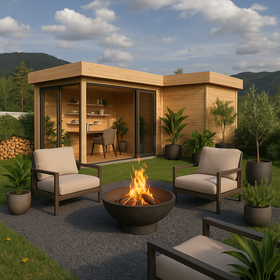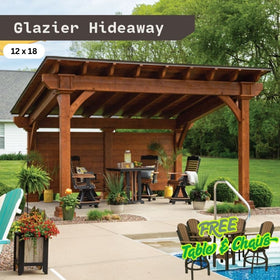512-777-0154

She Shed for Gym: Building Your Perfect Backyard Workout Studio
A she shed for gym is more than a backyard upgrade. It’s a personal workout spot that feels both private and energizing. You get a place that fits your training style without leaving home or sharing equipment with strangers.
With the right plan, you can turn a simple shed into a sturdy and stylish fitness studio.
1. Planning Your She Shed Exercise Room (Sizing & Layout)
Setting up your shed gym starts with smart planning. The size, layout, and flow of the space will shape every workout you do inside it.
Determining the Ideal Size: From Minimum 8x8 to the 10x12 Shed Gym
Your shed gym needs a size that fits your equipment and the way you move. Small sheds like The Versa 107 70MM can work. Larger ones feel more comfortable, especially if you mix strength and cardio.
Here’s a quick guide.
- 8x8: Great for yoga, bodyweight sessions, or a few dumbbells.
- 10x12: A popular size that fits a treadmill, bench, and floor space.
- 12x16: Roomy and flexible for multiple workout zones.
Choosing the right size starts with listing what you want inside and how much clearance each workout needs.
Equipment Footprints: Calculating Space for Cardio, Weights, and Mat Work
Every piece of equipment comes with a footprint. It helps to know the space each one fills before you place an order. A shed gets cramped fast if the math is off.
Typical equipment footprints:
- Treadmill: About 7 ft long and 3 ft wide
- Bike: Around 4 ft long and 2 ft wide
- Power rack: About 7 ft tall with a 4×6 ft footprint
- Yoga mat: Needs an open 7×3 ft patch
- Adjustable bench: 4–5 ft long plus wiggle room
Mapping these out keeps the layout clean and prevents bumping elbows on walls.
Legal Check: Understanding Permits, Ceiling Height, and Building Regulations
Before you start building, check local rules.
Most cities require a permit for larger sheds or anything wired for electricity. Ceiling height matters too. You need at least 8 ft for comfort and even more if you press weights overhead.
You may also have set-back rules that dictate where you can place the shed. A quick chat with your city’s building department can save a lot of trouble later.
2. Building vs. Buying: Prefab Gym Shed Options
Some people love the DIY route. Others want their gym delivered ready to go. Both paths work. It just depends on your budget, time, and skills.
Shed Gym for Sale: Comparing Turnkey vs. Kit Costs
You’ll see two main choices when browsing gym sheds for sale. Turnkey sheds arrive assembled. Kit sheds arrive in pieces. One trades convenience for cost.
Typical prices:
- Kits: $3,000 to $8,000, depending on size
- Turnkey sheds: $7,000 to $20,000, depending on materials and finishes
Turnkey feels faster. Kits let you customize and save money.
Evaluating Quality: What to Look for in She Shed for Gym Reviews and Materials
Quality makes a huge difference in how long your shed gym lasts. Solid framing, weather-resistant siding, and strong floors matter more here than in regular storage sheds.
Checklist for comparing options:
- Framing: 2×4 or 2×6 lumber
- Siding: Metal, wood, vinyl, or engineered panels
- Floor rating: Strong enough for weights and machines
- Reviews: Look for notes on durability, stability, and assembly difficulty
The better the shell, the easier the rest of your gym build will be.
Breaking Down the Shell Cost (The Base Price of the Structure)
The base structure is the “shell.” It includes walls, roof, windows, and a door. It doesn’t include insulation, electricity, or interior finishes.
Typical shell-only prices:
- 8x10: $2,500 to $5,000
- 10x12: $5,000 to $8,000
- 12x16: $8,000 to $12,000 or more
This is the starting point for your total budget.
3. Structural Essentials for a Heavy-Duty Shed Gym
A gym shed must handle weight, movement, and vibration. Building it right from the start keeps you safe and protects your equipment.
The Critical Foundation: Concrete Slabs and Reinforced Joists (Floor Load Capacity)
A strong foundation keeps your Q Bic ALU 44A steady through every deadlift and dropped dumbbell. Concrete is the top choice for heavy setups. If you use a wood floor, you’ll need reinforced joists spaced tightly for extra strength.
Aim for a floor load rating of 250 to 500 pounds per square foot. This covers machines, free weights, and impact from training.
Durable Gym Shed Flooring: Rubber Tiles and Shock Absorption for Dropped Weights
The floor is one of the hardest-working parts of a shed gym. It needs to be safe, quiet, and shock-absorbing.
Popular choices:
- Rubber stall mats (¾ inch): Best for lifting
- Interlocking rubber tiles: Good shock absorption and easy to install
- Foam tiles: Ideal for stretching or low-impact exercise
Skip hardwood or laminate. Weights leave dents fast.
Ensuring Security: Protecting Equipment and Maintaining Privacy
A shed gym should feel private and safe. Simple upgrades make a big difference.
Common security additions:
- Deadbolt locks
- Tinted or frosted windows
- Motion lights
- Cameras or alarms
These help protect your investment and keep the space peaceful.
4. Infrastructure and All-Weather Comfort
A gym is more enjoyable when the temperature is comfortable and the air feels clean. Your shed needs a few upgrades to make workouts pleasant year-round.
Climate Control: Insulation, Ventilation, and Protecting Electronics from Extreme Temperatures
Weather swings can shorten the lifespan of electronics and equipment. Adding insulation helps keep temperatures steady. Ventilation keeps air flowing and prevents humidity from building up.
Options to consider:
- R13 to R21 insulation
- Gable or soffit vents
- Mini-split heat pump for heating and cooling
- Portable heaters or fans as a budget choice
Good climate control protects both you and your gear.
Running Reliable Electricity and Lighting for Safety and Operation
Proper electrical work makes the shed safer and more functional. Most gym setups need more than one outlet.
Key electrical needs:
- Dedicated circuit
- GFCI outlets
- Bright overhead LEDs
- Extra outlets for machines and fans
It’s worth hiring a licensed electrician for this step.
Managing Air Quality: Fans, Dehumidifiers, and Cross-Ventilation
Sweaty workouts and an enclosed shed can create stuffy air. Keeping the space fresh helps your equipment stay in good shape and makes training more pleasant.
Useful additions:
- Oscillating fan
- Dehumidifier
- Operable windows for natural airflow
These small upgrades make a big difference in comfort.
5. Interior Design and She Shed Gym Ideas
Interior design gives your shed gym personality. A well-designed space boosts motivation and makes workouts feel smoother.
Creating the Studio Aesthetic: Mirrors, Color, and Natural Light
Mirrors are almost a must for any home gym. They help with form checks and brighten the room. Light colors also make small spaces feel bigger.
Skylights or larger windows can make morning workouts feel calmer and more inviting.
Maximizing Space with Vertical and Wall-Mounted Storage Solutions
Smart storage keeps the room clear and efficient. Wall space is your best friend.
Storage ideas:
- Wall-mounted racks for weights
- Pegboards for resistance bands
- Vertical barbell holders
- Fold-away benches or racks
A clutter-free shed makes workouts smoother.
Essential Finishings: Sound Systems and Motivational Elements
Finishings bring your gym to life. Music adds energy. Decor adds personality.
Fun additions include:
- Bluetooth speakers
- Motivational artwork or chalkboard walls
- TV or tablet stands for guided workouts
These touches help create a welcoming studio vibe.
6. Understanding the Total She Shed for Gym Cost
Every shed gym has a different price tag. Your choices, location, and equipment all shape the final number.
Price Comparison: Analyzing the Budget for DIY Conversion vs. Turnkey Solutions
DIY conversions cost less but take more time. Turnkey solutions cost more but get you training sooner.
General budget ranges:
- DIY: $5,000 to $15,000
- Turnkey: $10,000 to $25,000 or more
Choosing between the two depends on your timeline and comfort level with tools.
Cost Breakdown: Materials, Labor, Equipment, and Finishing Expenses
Here’s a simple breakdown of typical expenses.
- Shed shell: $3,000 to $12,000
- Foundation: $1,000 to $4,000
- Electrical: $500 to $3,000
- Insulation and walls: $800 to $3,500
- Flooring: $300 to $1,200
- HVAC: $800 to $3,000
- Equipment: $500 to $5,000 or more
The total depends on size, climate, and how much you want to add.
Long-Term Savings: Comparing the Investment to Annual Gym Memberships
Gym memberships often cost $600 to $1,200 every year. A shed gym pays you back over time, especially if you use it often.
Most people see savings within:
- 2 to 4 years for higher-priced memberships
- 5 to 7 years for budget gyms
Plus, you save time and enjoy total privacy.
A Backyard Upgrade That Truly Pays Off
A she shed for gym gives you a dedicated place to move, lift, stretch, and recharge. Even though the total she shed for gym cost can feel like a big project, the payoff is worth it. You get a sturdy foundation, a comfortable interior, and a space designed exactly for your goals.
Whether you choose a prefab setup or build your own version, focusing on structure and comfort keeps your gym safe, strong, and enjoyable for years.









